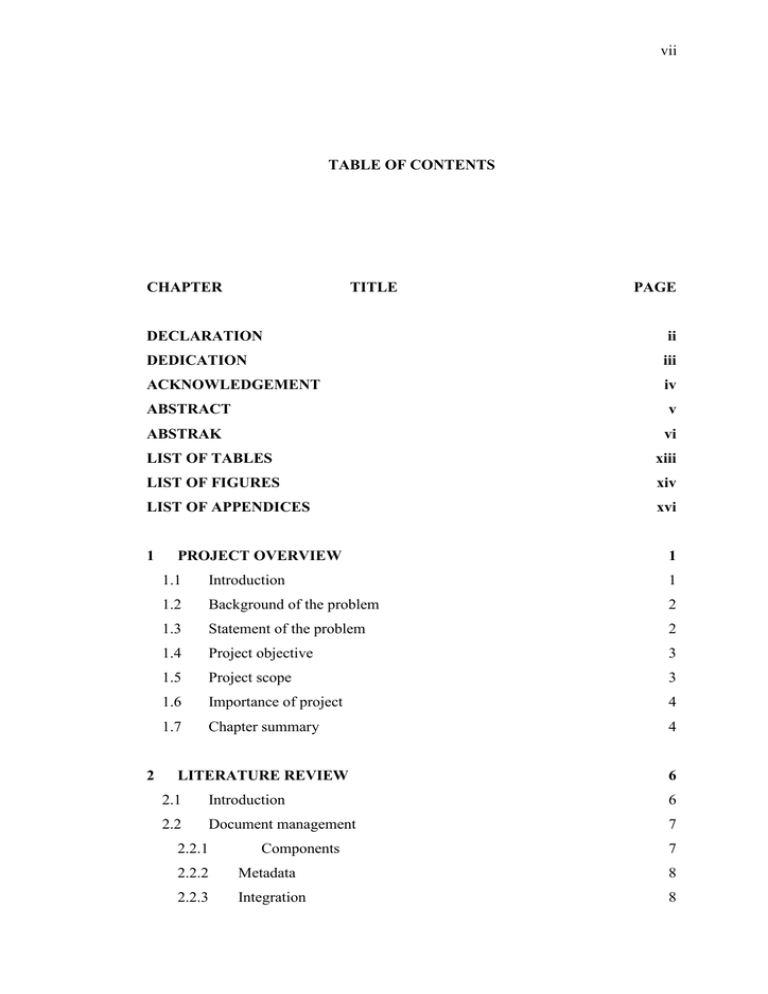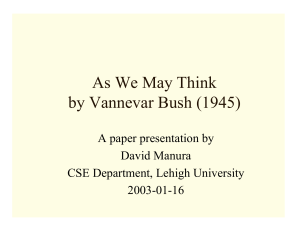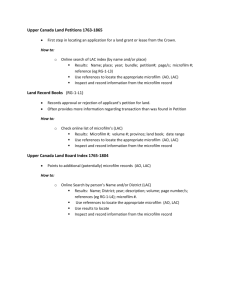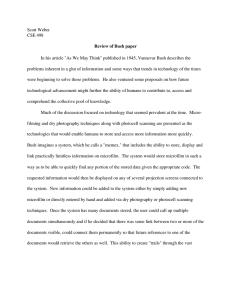vii TABLE OF CONTENTS
advertisement

vii TABLE OF CONTENTS CHAPTER TITLE PAGE DECLARATION ii DEDICATION iii ACKNOWLEDGEMENT iv ABSTRACT v ABSTRAK vi LIST OF TABLES xiii LIST OF FIGURES xiv LIST OF APPENDICES xvi 1 2 PROJECT OVERVIEW 1 1.1 Introduction 1 1.2 Background of the problem 2 1.3 Statement of the problem 2 1.4 Project objective 3 1.5 Project scope 3 1.6 Importance of project 4 1.7 Chapter summary 4 LITERATURE REVIEW 6 2.1 Introduction 6 2.2 Document management 7 2.2.1 Components 7 2.2.2 Metadata 8 2.2.3 Integration 8 viii 2.2.4 Capture 8 2.2.5 Indexing 9 2.2.6 Storage 9 2.2.7 Retrieval 9 2.2.8 Distribution 9 2.2.9 Security 10 2.2.10 Workflow 10 2.2.11 Collaboration 10 2.2.12 Versioning 11 2.2.13 Publishing 11 2.3 Digital Library 11 2.4 Archival System 13 2.4.1 Micrographics 13 2.4.1.1 Filming 13 2.4.1.2 Indexing 15 2.4.1.3 Processing 15 2.4.1.4 Storage 16 2.4.1.5 Retrieval 19 Digital imaging 20 2.4.2 2.4.2.1 Capture or Scanning 21 2.4.2.2 Indexing 22 2.4.2.3 Storage 23 2.4.2.4 Retrieval 23 2.4.2.5 Distribution 24 2.4.2.6 Digital Preservation 24 2.5 Advantages and disadvantages of each technology 25 2.5.1 Micrographics 25 2.5.2 Digital imaging 26 2.6 Resolution, the Key Design Element 27 2.6.1 Micrographics 27 2.6.2 Digital imaging 29 2.7 Image Access, Distribution, and Transmission 31 2.8 Microfilm Digitization projects 32 ix 2.8.1 Simon Fraser University Digital Retrospective Conversion of Theses 2.8.2 32 CRL/LAMP Brazilian Government Serials Digitization Project 34 2.8.2.1 Scanning Eguipment and Processing 36 2.8.2.2 Indexing the Document Collection 37 2.8.3 The Tundra Times Newspaper Digitization Project 39 2.8.3.1 Digitization Process 40 2.8.3.2 Microfilm Scanning 40 2.8.3.3 Metadata 41 2.8.3.4 OCR Processing 42 2.8.3.5 Costs 42 Microfilm Scanners 43 2.9 2.9.1 Canon Microfilm Scanner 800 MS800 SCSI Connection 43 2.9.2 ScanPro 1000 microfilm scanner 45 2.9.3 SpeedScan 3 in 1 Microfilm Scanner 46 2.9.4 FlexScan 2 in 1 Scanner for Rollfilm and Microfiche 48 2.10 3 and Dissertations Chapter summary PROJECT METHODOLOGY 51 52 3.1 Introduction 52 3.2 Project Methodology 53 3.2.1 Initial Planning Phase 53 3.2.2 Analysis Phase 53 3.2.2.1 Study Current System 54 3.2.2.2 Literature Review 54 3.2.2.3 Data Collection and Data Analysis 54 3.2.3 Microfilm Digitization 55 3.2.3.1 Scanning Process 55 3.2.3.2 Cataloging and Indexing Scanned Microfilms 57 3.2.4 Design 60 3.2.5 Implementation 60 3.3 System development methodology 3.3.1 3.3.1.1 63 The Unified Process 63 Inception Phase 64 x 3.3.1.2 Elaboration Phase 64 3.3.1.3 Construction Phase 64 3.3.1.4 Transition Phase 65 3.3.2 Object Oriented Approach 65 3.3.3 UML Notation 66 3.4 4 System Requirement Analysis 67 3.4.1 Hardware Requirements 67 3.4.2 Software Requirements 68 3.5 Project Schedule 69 3.6 Chapter summary 69 SYSTEM DESIGN 4.1 Organizational analysis 4.1.1 Introduction 4.1.1.1 Mission & Goals 70 70 70 71 4.1.2 Structure 72 4.1.3 Functions 72 4.1.4 Problem statement in the organizational context 73 4.1.5 Case study 73 4.1.5.1 Introduction 4.1.5.2 The process of filming and storing of microfilms in Sultanah Zanariah Library 4.2 As-Is Process and Data Model 73 75 78 4.2.1 Use Case Diagram 78 4.2.2 Use Case Description 80 4.2.3 Sequence Diagram 83 4.2.4 Activity Diagram 85 4.3 To-Be Process and Data Model 86 4.3.1 Use Case Diagram 86 4.3.2 Use Case Description 87 4.3.3 Class Diagram 90 4.3.4 Sequence Diagram 90 4.3.5 Activity Diagram 91 4.4 System Architecture 92 xi 4.5 5 Database Design 95 4.5.2 Program (Structure) Chart 96 4.5.3 Interface Chart 97 4.5.4 Detailed Modules/Features 98 4.6 Hardware Requirements 101 4.7 Chapter summary 102 DESIGN IMPLEMENTATION AND TESTING 5.1.1 5.2 7 95 4.5.1 5.1 6 Physical Design Coding Approach Snapshot of Critical Programming Codes Test Result/ System Evaluation 103 103 105 106 5.2.1 Unit Testing 106 5.2.2 User Acceptance Test 108 5.3 User Manual 108 5.4 Chapter summary 109 ORGANIZATIONAL STRATEGY 110 6.1. Rollout Strategy 110 6.2. Change Management 111 6.3. Data Migration Plan 113 6.4. Business Continuity Plan (BCP) 114 6.5. Expected Competitive Advantage Gain from the Proposed System 114 6.6. Chapter summary 115 CONCLUSIONS 116 7.1 Introduction 116 7.2 Achievements 117 7.3 Constraints and Challenges 117 7.4 Aspirations 118 7.5 Future work 118 7.6 Summary 119 xii REFERENCES 120 Appendices A-H 122-166 xiii LIST OF TABLES TABLE NO TITLE PAGE 2.1 Attributes of Micrographics 25 2.2 Attributes of Digital Imaging 26 2.3 Per Page Digitization Costs 42 2.4 SpeedScan Hardware Specifications 46 2.5 FlexScan w/NextStar Specifications 49 3.1 Detail every phase in project Methodology Framework 61 3.2 Software required developing the system 68 4.1 Use Case Description for Enter request 80 4.2 Use Case Description for Get microfilm call number 81 4.3 Use Case Description for Get microfilm 81 4.4 Use Case Description for View thesis 82 4.5 Use Case Description for Search thesis 88 4.6 Use Case Description for Get list of theses 88 4.7 Use Case Description for View thesis 89 4.8 Database design for the Web-based Document Management and Filing Archival System 95 4.9 Hardware Requirements for proposed system 101 5.1 System evaluation test for Clients of the proposed system 106 5.2 System evaluation test for Staff of the proposed system 107 xiv LIST OF FIGURES FIGURE NO TITLE PAGE 2.1 Planetary Microfilmer 14 2.2 Rotary Microfilmer 15 2.3 Archival vault 16 2.4 Positive roll film 18 2.5 Aperture card 18 2.6 Microfiche card 19 2.7 Microfilm reader 20 2.8 Overhead Scanner 22 2.9 Project Website[http://www.crl.uchicago.edu/info/brazil] 37 2.10 Pagination File 245 38 2.11 Table of Contents 38 2.12 Subject headings 39 2.13 Canon MS800 Microfilm scanner 44 2.14 ScanPro 1000 Microfilm scanner 46 2.15 SpeedScan 3 in 1 Microfilm Scanner 47 2.16 FlexScan 2 in 1 Microfilm Scanner 51 3.1 Background Recognition process 56 3.2 OCR Processing 58 3.3 PDF saving options 59 3.4 PDF Security Settings 59 4.1 Microfilm reader machine 74 4.2 The process of thesis unbinding 75 xv 4.3 The process of filming pages by Planetary Microfilming camera 76 4.4 Microfilm processor 76 4.5 The process of checking microfilm 76 4.6 Microfilm archive vault 77 4.7 Silica gel inside of shelves 77 4.8 Use Case Diagram for As-Is System 79 4.9 Sequence Diagram for View thesis 84 4.10 Sequence Diagram for Give microfilm 84 4.11 Activity Diagram for current process 85 4.12 Use Case Diagram for To-Be System 87 4.13 Class Diagram 90 4.14 Sequence Diagram for User of proposed system 91 4.15 Activity Diagram for proposed system 92 4.16 Digital Library Network 93 4.17 System Architecture 94 4.18 Database Design 96 4.19 Interface Chart 98 4.20 Main page of Student Module 99 4.21 Manage Librarian from Admin Module 100 4.22 Add Thesis menu from Librarian Module 101 6.1.. Implementation guideline for proposed system 104 xvi LIST OF APPENDICES APPENDIX TITLE PAGE A Gantt Chart 122 B Interview Questions 129 C Organizational Chart of PSZ Library 131 D Database Design 133 E Critical programming codes 135 F User Acceptance Test Questionnaires 142 G 5 samples of user’s feedback 145 H User Manual and Technical Documentation 150


